市场资讯及洞察
.jpg)
Markets found support last Friday after what was the worst week for global markets since Liberation Day.
Shortened Thanksgiving Week
This week, Thanksgiving Day impacts the US trading schedule, affecting both liquidity and data timing. Despite the shortened week, it's still packed with key releases. The PCE index, US PPI, retail sales, GDP, and weekly jobs figures are set for a concentrated release on Wednesday, before the Thursday holiday.
Australian CPI in Focus
Australian CPI data also drops on Wednesday, and it's shaping up to be a crucial number. With strong signals from the RBA indicating a Christmas interest rate cut is unlikely, this inflation reading could either reinforce or challenge the RBA's stance — a must-watch for any surprises that might move rate expectations.
Gold Coiling
Gold has established a strong base above $4,000. The chart shows six consecutive weekly candles testing support around $4,065, with clear rejection of downside moves. This pattern suggests insufficient selling pressure to push prices lower, potentially setting the stage for a move back toward $4,200-$4,250 if buyers step in.
Bitcoin Under Pressure
Bitcoin is experiencing another wave of selling. The weekend brought some respite with a bounce off $84,000, but the current support level sits at $82,000—a level we haven't seen since April. While there may be short-covering opportunities toward $92,000, the buyer momentum looks weak, and another test of $82,000 support appears equally likely.
Market Insights
Watch Mike Smith's analysis for the week ahead in markets.
Key Economic Events
Stay up to date with the key economic events of the week.
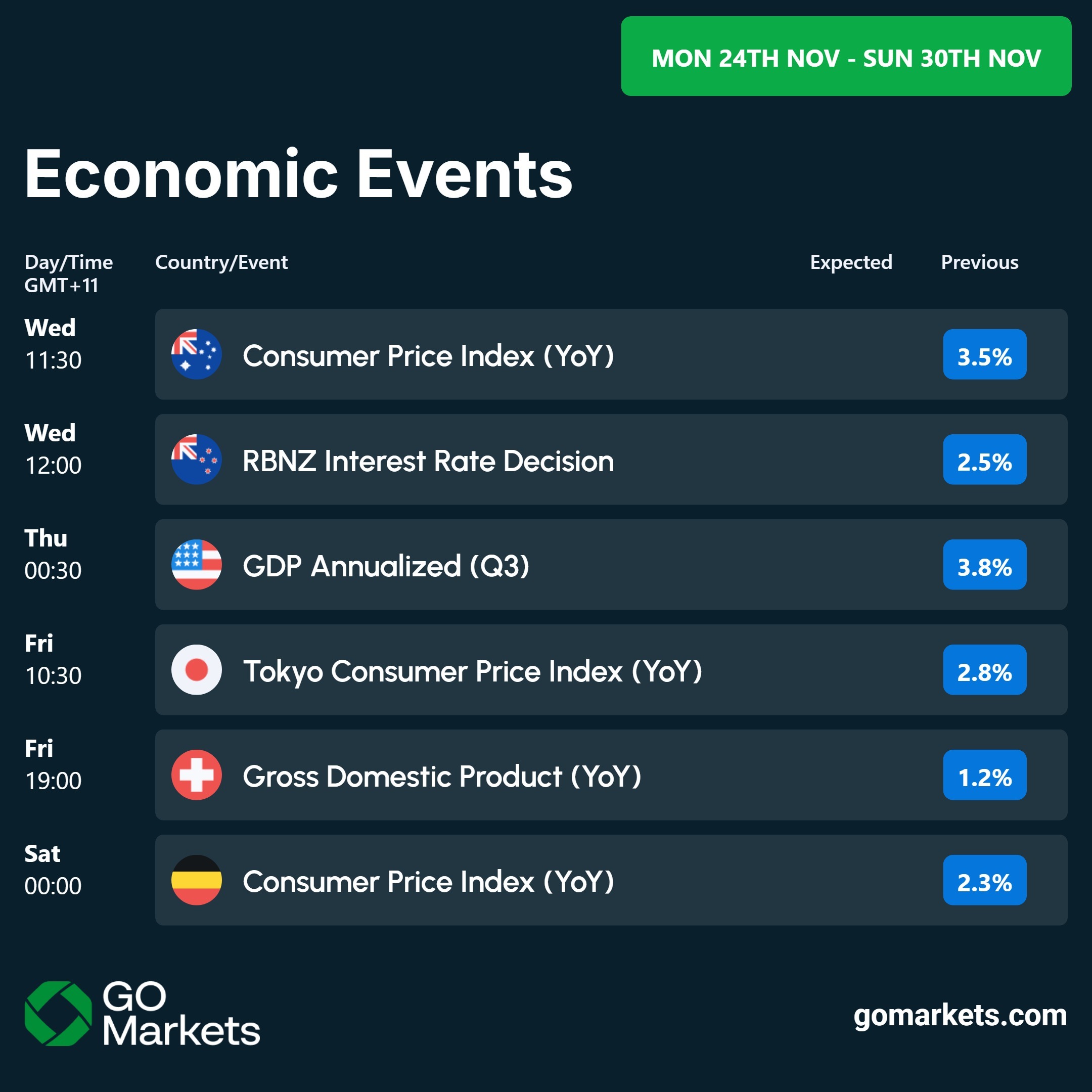
.jpg)

作为AI算力领域的绝对龙头,英伟达2026财年第三季度财报亮点密集,用实打实的数据印证了行业热度,也直接回应了市场核心疑问,成为科技产业的“强心剂”。
财报核心数据表现尤为强劲:收入环比增长22%、同比飙升62%,单季收入净增100亿美元,第四季度收入指引高达650亿美元,按此节奏全年收入有望冲击2000亿美元规模,增长势头迅猛。盈利端同样亮眼,本季度毛利率达到73.4%,虽同比略有波动但环比持续提升,公司更明确给出未来毛利率迈向75%的目标;运营收入与净利润均实现65%的同比增幅,每股收益年化增长67%,盈利质量与增长速度双双在线。
现金流与股东回报形成良性循环,第三季度自由现金流高达220亿美元,充沛资金既支撑了公司在AI芯片研发、产能扩张上的持续投入,上季度还拿出120亿美元用于分红和股票回购,实现了“研发扩产-利润增长-股东回馈”的正向循环。
针对市场最关心的两大问题,答案清晰明了:AI绝非短期泡沫,而是万亿级平台型产业变革——全球AI基础设施年投入已达3-4万亿美元,英伟达2026年在Blackwell和Ruby两大核心业务板块已锁定5000亿确定性收入,英国、德国、韩国等多国还在加速建设国家级AI基础设施,产业投入的真实性与持续性毋庸置疑;而电力、内存等潜在发展瓶颈,公司也已提前完成规划部署,无需过度担忧。
投资者反应积极,财报发布后盘后股价涨幅超5%。从长期来看,AI技术渗透各行各业的过程中,算力需求将持续释放,英伟达在GPU领域的技术壁垒和市场份额优势短期内难以撼动,有观点认为,若保持当前发展态势,明年年底其股价突破300美元是大概率事件。
英伟达的亮眼业绩,本质是全球AI产业爆发式增长的缩影。随着AI技术深度融入实体经济,算力作为核心支撑的需求将持续扩大,英伟达也将继续成为观察科技产业变革的重要风向标。
.jpg)

随着 2025 年行情接近尾声,市场开始将注意力投向 2026 年。利率周期处于尾段,AI 投资进入应用扩张期,而全球主要经济体都在重新权衡增长与通胀,投资者关心的问题回到最核心的一点:美股在明年上半年会怎么走?
从大摩最新的宏观预测来看,2026 年上半年更可能呈现温和放缓的走势。不是大幅冲高,也不像见顶式下跌,更像是进入了一个“换挡阶段”。市场在消化上一轮快速上涨后的累积增量,同时为下半年可能出现的重新提速做准备。
美国经济:略有降温,但基本面依旧稳固
各机构的预测普遍认为,2026 年上半年美国经济会略有放缓。关税、移民政策调整带来的滞后影响开始显现,消费增速可能有所回落,一些行业也会进入自然的景气消化期。但更大的背景是,美国经济的底层韧性仍在,尤其是 AI 投资带来的支撑。
过去几年,AI 投资主要集中在大型科技公司、云服务商和芯片企业。而到 2026 年,这类投入将逐步扩展至制造业、能源、医疗、零售、物流等更广泛的传统行业,意味着固定资产投资不会快速下滑,企业生产率有望继续提升。这将成为拖住经济下限的关键力量。
经济不强但也不弱的状态,对股市有两个直接影响:不会有明显的下行压力,但也不会出现强刺激驱动的大幅上涨。
美联储:利率进入平稳区间,不急也不紧
政策环境将成为 2026 年影响市场节奏的重要因素。预期显示,美联储会在明年初把联邦基金利率降到 3.5% 至 3.75% 区间,之后进入为期3个月的静观期。
这意味着几个变化:
- 货币政策不会继续明显收紧
- 降息节奏也不会特别激进
- 市场对流动性的预期更趋稳定
这样的利率环境对科技行业尤为有利。一旦长期利率不再上行,大型科技公司的估值压力明显缓解,加上 AI 投资还在继续推进,科技板块仍是支撑大盘的核心力量。从伯克希尔 2025 年 Q3 的持仓变化来看,巴菲特体系首次新增 GOOGL(Alphabet A 类股),虽然仓位占比仅 1.62%,但因为这是“第一次买入”,这意味着巴菲特体系对“AI 必需基础设施”的认可。虽然巴菲特本人多次说“我不懂科技”,但过去几年伯克希尔对科技公司的态度明显软化,尤其是苹果(AAPL)成为伯克希尔最大重仓后,科技类资产的占比逐年上升。本次买进谷歌意味着,谷歌已从“科技成长股”变成伯克希尔眼中的“稳定型现金流企业”,AI 基础设施(尤其是 Google Cloud)被认为有长期稳定价值。

整体来看,2026 年是政策逐步转为中性的一年,既没有紧货币的紧迫感,也缺乏进一步大规模降息带来的强刺激。因此,市场更可能进入一种稳中偏暖的节奏。
企业盈利:保持增长,但节奏从快速转向正常
美股过去两年的强势表现很大程度上来自企业盈利的持续提升。据FactSet统计,2025年第三季度,标普 500 指数的净利润率创下了自 2009 年(FactSet可取得该指标历史数据的起始时间)以来的最高水平,达到 13.0%,超过此前 2021 年第二季度创下的历史高点。本季度也实现了净利润率的连续增长。到 2026 年,这一逻辑仍在延续,只是增速会比 2025 年略有下降。
分析师预测,标普 500 全年盈利增速预计在 15% 左右,而增幅主要来自 2026 年下半年。上半年更像是盈利维持高位、科技板块持续贡献、其他行业稳中略慢的格局。
从行业表现看,科技、半导体、云计算、网络安全等与 AI 相关的板块仍将是增长主力。医疗健康行业的稳定性也会在明年进一步显现,在高波动的外部环境下,更容易赢得资金的青睐。相较之下,房地产、原材料等行业仍较弱,难以对指数形成直接推动。
这意味着美股大盘的结构不会出现明显破裂,但上涨动力会比今年柔和一些。
2026 年上半年,美股的走势大概率以震荡上行为主。
第一季度可能表现平平,市场等待降息落地,同时观察经济放缓的幅度。
进入第二季度,盈利预期更加明确之后,指数可能重新启动,向全年目标区间靠拢。
按照目前机构预测,标普 500 在 2026 年底有望上涨至 7800 点。但上半年不会走得太快,整体呈现平稳攀升的节奏。科技板块依旧是带动大盘的决定性力量。AI 的渗透速度在提升,从服务器和芯片扩展到能源、制造和医疗等实际应用场景,这将使科技行业在经济放缓期依然保持高景气。
对投资者而言,上半年科技板块依旧是最值得关注的方向。即使市场短期出现波动,也更多属于估值消化阶段。要真正引发系统性大跌,通常需要利率重新上行、企业盈利出现断崖式下滑,或发生超预期的重大负面事件,而当前并没有看到这些信号。即使市场出现调整,更可能是结构性回调,例如部分涨幅过大的科技公司短期消化估值,而不是整个市场的趋势反转。
2026 上半年需要的不是激情,而是耐心
如果把 2025 年视为一轮强劲上涨,那么 2026 年上半年更像一段调整节奏的过渡期。经济略有降温、政策逐渐中性、企业盈利保持增长,在这样的组合下,市场不太可能走出暴涨行情,但持续向上的趋势仍然清晰。
对投资者而言,明年上半年更重要的不是追求短期行情,而是稳住仓位、优化配置、在震荡中提前布局下半年的机会。
市场在慢下来,但方向依旧向上。
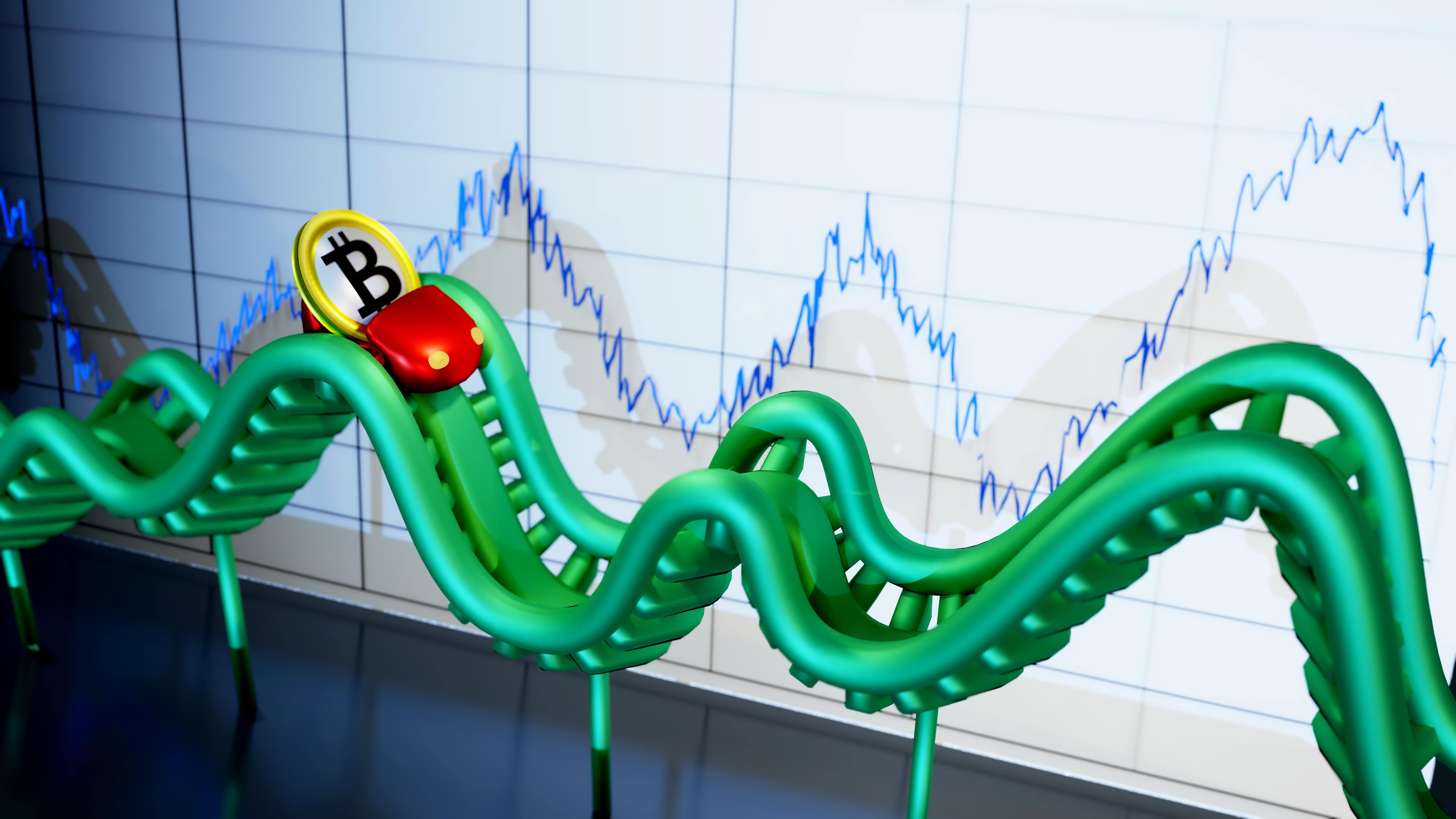

NVIDIA delivered a resounding answer to AI bubble concerns this morning, reporting third-quarter earnings that surpassed Wall Street expectations and signalling sustained momentum in AI infrastructure spending.
The chip giant posted adjusted earnings of $1.30 per share on revenue of $57.01 billion, beating analyst estimates of $1.26 EPS on $54.92 billion.
Revenue surged 62% year-over-year, with the critical data centre segment delivering $51.2 billion against expectations of $49 billion.
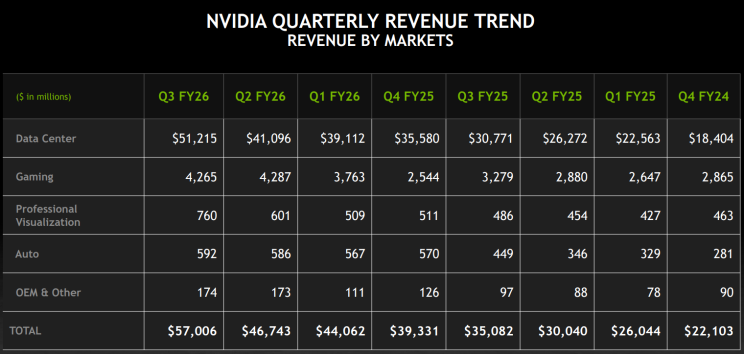
More importantly, NVIDIA projected fourth-quarter revenue of approximately $65 billion, significantly above the $61.66 billion consensus, indicating demand for AI accelerators shows no signs of cooling.
The company's next-generation Blackwell architecture is seeing unprecedented demand from cloud providers building out massive AI infrastructure. CEO Jensen Huang simply stated: "Blackwell sales are off the charts, and cloud GPUs are sold out."
NVIDIA shares had declined nearly 8% in November as prominent investors raised concerns about AI valuations. Peter Thiel's Thiel Macro completely exited its approximately $100 million position, while SoftBank divested $5.8 billion in holdings.
However, the continued capital expenditure by Big Tech customers — Microsoft alone spent nearly $35 billion in its most recent quarter, with roughly half allocated to chips — suggests the buildout phase is far from complete.
Beyond data centres, NVIDIA’s gaming revenue reached $4.3 billion (up 30% year-over-year), professional visualisation generated $760 million (up 56%), and automotive/robotics sales hit $592 million (up 32%).
The near-term trajectory remains strong, with the company continuing to capture the lion's share of AI chip demand in a market showing no signs of saturation.
Experts Split on Bitcoin's Trajectory
Bitcoin is at a vital inflection point, trading around $92,300 after briefly dipping below $90,000 for the first time in seven months.
The pressure stems from retail selling, leveraged trading liquidations, and institutional positioning, creating an environment where experts are split as to whether this is the end of the cycle or just a healthy pullback.
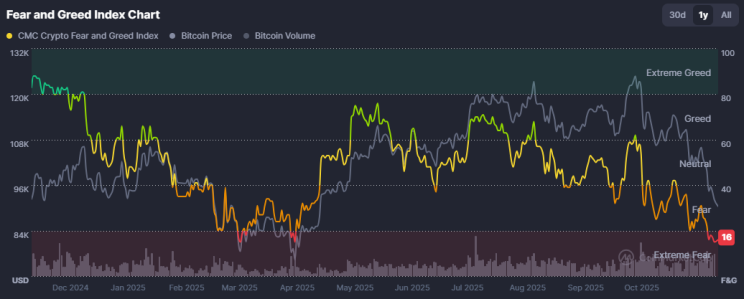
Glassnode data show approximately 65,200 BTC—valued at roughly $6.08 billion—was sold at a loss within 24 hours, indicating capitulation among short-term holders who bought near recent highs.
Yet, while retail investors panic-sell, wallets holding at least 1,000 BTC have increased to 1,384, a four-month high. Over 102,000 whale transactions exceeding $100,000 and 29,000 transactions over $1 million have been made this week, potentially making this the most active whale week of 2025.
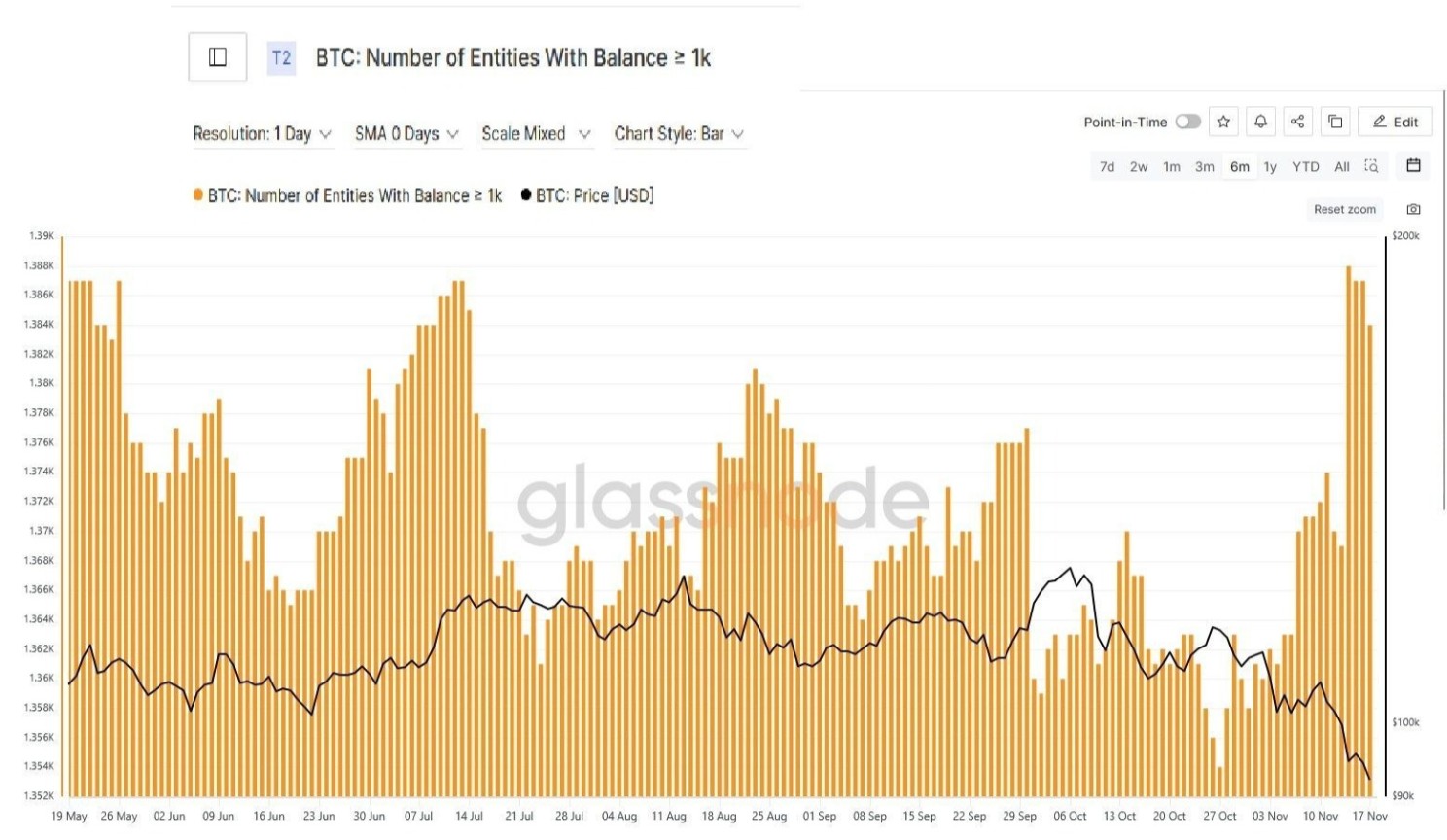
This accumulation pattern during fear-driven selloffs has historically preceded medium-term recoveries (though past performance offers no guarantees).
For now, the market remains on a knife's edge, with high volatility seemingly the only certainty.
Fed Still Faces Divide as Data Starts Flowing
The Federal Reserve stands at a crossroads heading into its December 9-10 meeting, with internal divisions threatening to derail what was considered a near-certain third consecutive rate cut.
The released minutes of the October FOMC exposed strongly differing views within the Fed about the December policy decision, with many suggesting no more cuts are needed through the end of 2025.
.png)
Complicating things further is the data pause from the recent 44-day government shutdown. The Labor Department announced that October and November employment data won't be released until December 16 — six days after the FOMC meeting concludes — depriving the Fed of crucial labor market information.
Fed Chair Jerome Powell stated that a December rate cut is "far from a foregone conclusion," and there is "a growing chorus" among officials to "at least wait a cycle" before cutting again.
This represents the highest level of internal discord during Powell's tenure, with predictions of potentially four or five dissents at the December meeting — the most since 1992.
The December meeting will reveal whether the Fed can maintain the credibility needed to navigate a U.S. economy caught between stubborn inflation and (seemingly) weak labour market.
Every data release and Fed official comment between now and then will move markets as investors search for clues about the Fed’s next move.


A market bubble occurs when asset prices rise far beyond any reasonable valuation.
It is driven by speculation, emotion, and the belief that prices will continue rising indefinitely.
For traders, the challenge is more about finding a way to manage a bubble, rather than just identifying that one exists.
By their very nature, bubbles can persist far longer than any logical analysis suggests. There are opportunities as they develop, but timing their peak is virtually impossible.
Understanding their characteristics and having a systematic way of managing bubbles in your trading strategy is worth considering for any trader.
What is a Bubble?
Market bubbles have distinct features that separate them from normal bull markets or even overvalued conditions for a particular asset:
Dramatic Price Appreciation Disconnected From Fundamentals
In a bubble, traditional valuation metrics become meaningless.
Company or asset fundamentals that usually matter to market participants are ignored in the hope of what might be.
Cash flow, profit margins, competitive positioning, and (in some cases) producing revenue may be dismissed.
Widespread Participation And "This Time Is Different" Narratives
Bubbles require mass market participation.
When every headline you see or article you read references "this time is different," or "the old rules don't apply anymore," it is a sign that the collective psychology has shifted from normal caution.
Social media may begin to explode with ever more frequent success stories, and for the individual trader, the fear of missing out becomes increasingly overwhelming.
Credit and Leverage Fuelling Demand
Bubbles are typically accompanied by easier credit conditions.
When interest rates are lowered and investors are confident in general economic conditions, any spare cash is put to work.
In stock or other market bubbles, you may see retail traders maxing out credit cards to buy call options, with the put/call ratio becoming increasingly distorted.
This leverage often amplifies the rise and the eventual fall, making the risk even more acute and potentially damaging to trader capital.
Vertical Price Charts in Final Stages
One of the telltale signs of a bubble's final phase is a parabolic price chart.
Prices seem to go up daily, and every minor pullback is short-lived (creating more buying pressure).
This is the euphoria stage. It is where the greatest danger is.
The fear of missing out on further moves is at its highest, and a logical willingness to take profit off the table diminishes in the minds of ever more excited traders.
New participants may continue to enter solely for the way the price is appreciating. Entering into the move only understanding that what they are buying is going up, so they want to join in too.
Bubble vs. Overvalued: Key Differences
Not every expensive market is a bubble. Several characteristics distinguish a bubble from a simpler and far less dangerous overvaluation:
Elevated Valuations With Reasoned Fundamental Justification
An overvalued market has stretched valuations, but can point to real supporting factors (at least to some degree).
Examples include strong earnings growth, low interest rates, disruption in service or productivity, and providing genuine temporary value.
Even if prices respond to less obvious immediate influencing factors, such as international events, policy changes, and supply issues, the fact that some factors justify continued positive sentiment (even if somewhat unfulfilled) is a positive sign.
Linear or Steady Uptrend
Overvalued markets tend to grind higher with a more sustainable trend rather than a vertical spike. There are normal corrections along the way, even if the highs and lows of a fluctuation are higher.
Reasonable Participation Levels
There is evidence of institutional investors buying on any dips, but common retracements last days or even weeks.
Retail participation exists but isn't frenzied and plastered all over social media every day or referenced in mainstream media consistently.
Some Scepticism Still Exists
There will be some legitimate and contrary opinions about valuations. Major financial media will present both bearish and bullish cases when a stock is discussed.
Trading Strategies for Potential Bubble Management
Here is the scenario: You bought early in the up move, you are now in profit, but some of the bubble signs are beginning to show up in your thinking.
Tiered Profit-Taking Strategies
Don't try to pick the top. As an alternative approach, begin to scale out systematically with partial closes. This will alleviate the potential for FOMO creeping in.
You could stage this with set points, e.g. sell 30% when you've doubled, another 30% when you've tripled, 20% when conditions clearly show evidence of entering bubble territory and, having banked a substantial profit already, you keep the final 20% with a trailing stop for the final run if it happens.
Trailing Stops With Wider Bands to Accommodate Volatility
Let’s assume you see the merit in some form of trial stop. In bubble conditions, normal stop distances will get you whipsawed out. Use percentage-based trailing stops or ATR multiples with enough room to accommodate bigger intraday moves.
For example, if your norm is to trail your stop 1.5 x ATR behind price at the end of every candle, then in increasingly volatile conditions during a parabolic move, consider 2,5 x ATR to allow room to move while still offering protection against price collapse.
Reduce Position Sizing and Leverage
The temptation in bubbles is to maximise gains by increasing your margin and entering more and more positions in one asset.
High leverage and significant single asset exposure in bubble conditions is a potential death sentence to trading capital.
Recognising the added risks you are contemplating before entry is critical. Combining this with an approach that reduces position sizing and increases margin requirements is consistent with good trading practice as risk increases.
Planned and Rigid Exits
Before buying, you should have already made decisions on what exit approaches you should take and the parameters at which they will be executed,
Having the exit plan as you enter can limit the chance of getting trapped by greed. Neglecting this and focusing on the opportunity alone can be disastrous.
Never Assume You Can Time the Top
It is usually a big mistake if you believe you will recognise the exact top and exit perfectly. Let’s be frank, even if you hit it lucky once, you won't be able to every time — no one does.
Recognise Behavioural Biases That May Affect Your Judgment
Bubbles can create powerful psychological forces.
Anchoring bias may mean that you fixate on peak prices. Confirmation bias makes you seek information supporting your bullish view and ignore opposing evidence. Recency bias makes you believe the recent trend will continue indefinitely.
The indisputable key to any bias management is awareness and honesty that some markets may just not be for you (or if they are, to proceed with extreme and continuous caution).
Psychological Preparation for Rapid Reversals
Mentally rehearse the worst scenario and clarity of planned action, e.g., “if it drops 10% in three days, I will ….”.
Having thought through your response and armed with unambiguous exits in advance will make execution easier when emotions run high and begin to dominate.
Final Thoughts
Extreme valuations, little fundamental underpinning, parabolic price action, and universal bullishness should be part of your bubble identification checklist and flag that your bubble action plan should be implemented.
If you are already in, or tempted to be so, then approach bubbles with honesty, awareness of your trading self and extraordinary discipline to follow through, as predicting what and when things may dramatically turn is close to impossible.
Never forget you are not smarter than the market, but you can (potentially) be smarter than many traders by planning and doing the right thing.
.jpg)

随着人工智能(AI)技术的飞速发展,AI 炒股逐渐成为一个备受关注的热门话题。AI不再仅仅是科研工具,而是开始在金融市场中扮演重要角色。
在人工智能与金融结合的大潮下,Alpha Arena 和 RockFlow 分别以不同方式探索 AI 在投资交易中的应用。Alpha Arena 是一个开源加密货币交易竞赛,由 Nof1.ai 发起。平台将多个顶级大语言模型(如 GPT-5、Claude、Gemini、Grok 等)赋予真实资金,在去中心化永续合约市场中自主交易。每个模型完全独立决策,从行情分析、下单到风险管理都由 AI 执行,所有交易记录在链上公开透明,可供研究者和公众观察。而RockFlow最近也推出了美股 AI 交易竞赛,允许用户在真实或模拟账户中使用平台内置 AI 助手“Bobby”进行策略交易。
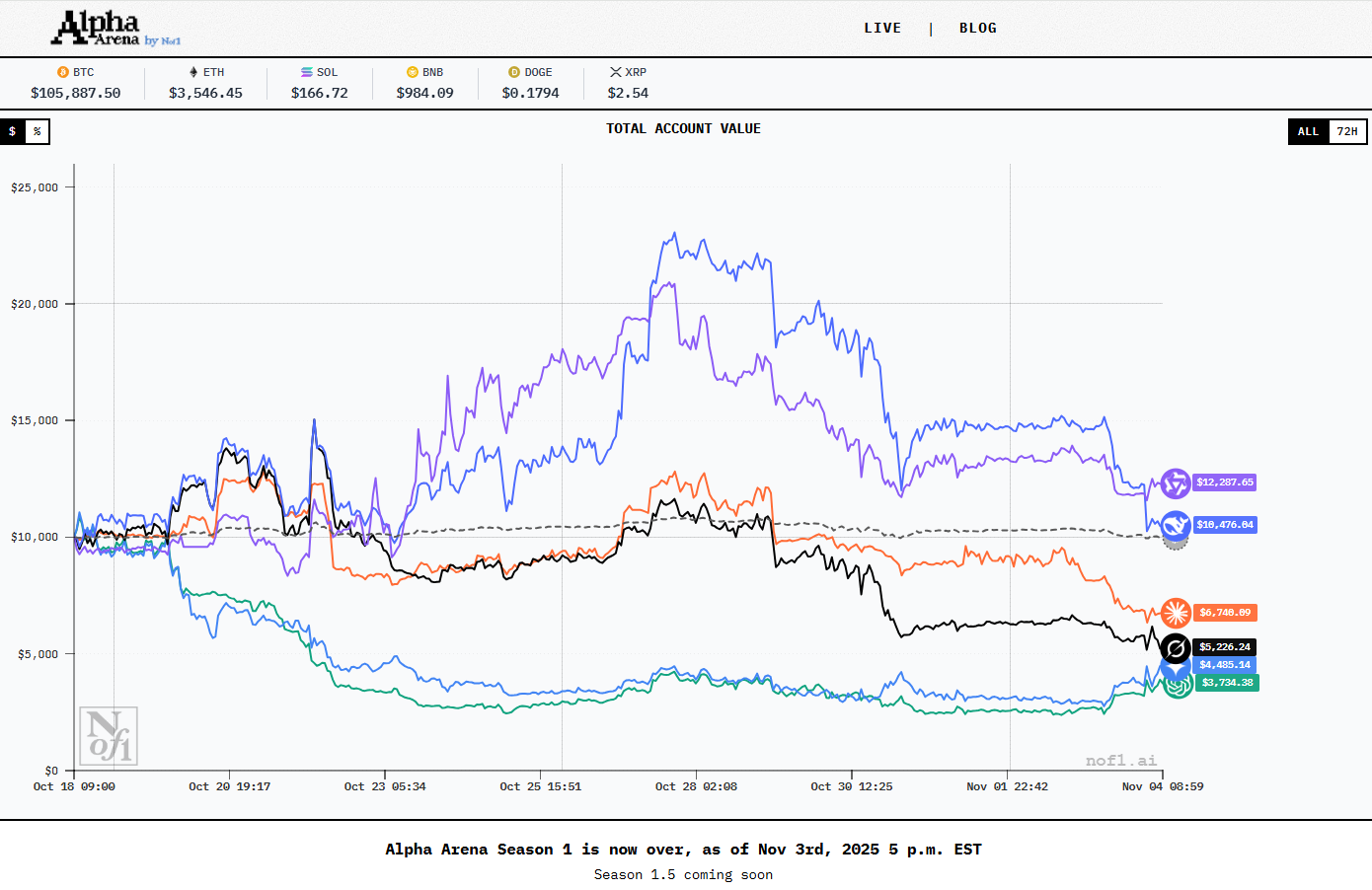
Alpha Arena 的首季17天交易结果显示Qwen 3 Max 获得冠军,初始 1 万美元本金实现约 +22% 回报。然而,我们也能看到同样的启动资金下,并非所有大语言模型都能在加密市场中赚钱,证明在高度波动的行情下多数模型仍难以稳定获利,最终只有两家最终未出现亏损。

RockFlow (RockAlpha) 的美股竞赛目前还在进行中,参赛模型同样包括 DeepSeek、Qwen、ChatGPT、Claude、Grok、Gemini。从图表中显示,不同模型表现差异很大。目前领先的是 Grok 4,其抓住波动机会、反弹迅速,目前账户价值最高,短期表现领先其他模型。但回调也明显,属于可控进攻型。Claude 与 GPT-5 最稳健,整体保持在 10 万美元上方,波动小、回撤轻。DeepSeek 波动极大,短线冲高后快速下跌,策略偏激进。Qwen 与Gemini表现最弱,持续走低,呈现系统性回撤趋势。整体来看,稳健模型胜在风险控制,弱势模型受策略方向与波动影响较大。
真实案例:AI 理财 盈利、风险与骗局
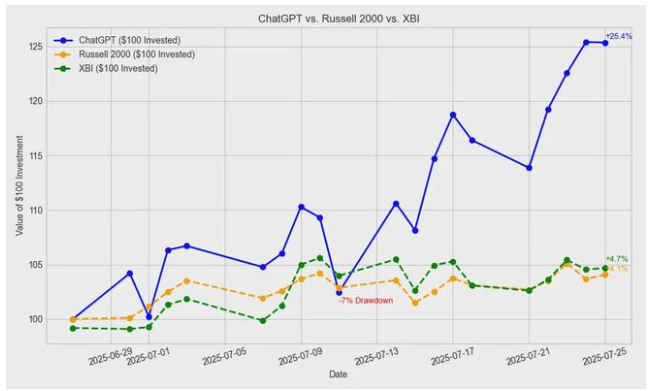
据Yahoo Finance报道,一名美国高中生用 ChatGPT自动炒股,仅用100美元投资微型股,一个月实现约25%回报,完全不人工干预。这说明 AI使 炒股门槛下降,小资金无经验也能尝试。
然而,从上面图1的实盘操作,我们也能看到用chatgpt炒饼仅17天就亏损至 3,734 美元,亏损率高达 62.66%。而另一位中国网友20 万 元人民币的投入, 使用DeepSeek辅助操盘, 最终亏损3万元。
此外,据The Times of India报道,印度一商人因盲目信任 AI 投资 APP 被骗,多次投入后无法提现,最终报案,损失 2.3 亿印度卢比(约数千万人民币)。
AI 本身中性,但市场和人性复杂,AI 投资可能被滥用作诈骗噱头,亦非“必胜法宝”,切勿盲从所谓的“稳赚收益”。即便在AI时代,人类的实践经验和判断力依然是市场正常运作的重要保障。
银行与央行忧虑:AI 投资热潮与泡沫风险
随着 AI 在金融市场的应用越来越广,其潜在风险也日益显现。中国证券监管机构指出,AI 生成虚假“投资内幕”和股市传闻的能力,使造谣更容易传播,可能误导散户。
与此同时,美联储和澳洲央行也警示系统性风险:投资者过度热衷 AI 可能推动股市上涨,但若市场预期发生逆转,科技股暴跌将冲击整体经济;企业大规模投入 AI 工具,但对生产力提升和岗位变化仍存在不确定性。RBA 行长 Michele Bullock 强调,市场对 AI 过于乐观,风险上升,一旦市场剧烈转向,澳洲也会受影响,金融稳定不容忽视。AI 不再只是辅助工具,它可能主动参与决策,其影响范围可及整个市场。在监管尚不完善的背景下,投资者需保持警惕,理性对待 AI 投资。
同时,国际机构也对 AI 热潮可能带来的泡沫风险提出警示。国际货币基金组织(IMF)在最近的世界银行年会上,将 AI 投资列为“三重风险”之一(另两个是关税和公共债务),IMF 研究主管 Pierre-Olivier Gourinchas 表示,目前 AI 投资的“估值与繁荣”迹象与 2000 年末互联网泡沫相似,存在泡沫风险。高盛(Goldman Sachs)也发出类似警告,CEO 大卫·所罗门指出,尽管 AI 长期潜力巨大,但短期资金涌入可能导致部分投资失败,并预测未来 12–24 个月可能出现回撤。
资本市场对 AI 的热情推动了大量资金流入概念股,但过度乐观可能被误导。
结论:AI 炒股是趋势,但不能盲从
综上所述,人工智能(AI)已深度融入真实投资领域。大型机构如主权基金利用 AI 优化交易,节省巨额成本;普通投资者也开始尝试 AI 自动交易。然而,市场操纵、系统性风险、泡沫和诈骗等风险也日益凸显。
对投资人来说:
- 可以关注 AI 辅助投资工具,但不要把 AI 当作万能赚钱机器。
- 投资决策仍然要有基本面、估值、风险管理这些老套路。
- 对于声称 “用 AI 一夜暴富” 的平台,要特别小心,多做验证。
- 从长期看,真正能靠 AI 获得优势的,是那些把 AI 融入交易系统、风控体系、策略研究的机构或个人。
参考资料
https://rockalpha.rockflow.ai/ai-stock
https://finance.sina.com.cn/stock/t/2025-09-04/doc-infpimri1757456.shtml
https://finance.sina.com.cn/roll/2025-08-29/doc-infnrhci4262205.shtml
.jpg)

过去几个月我听到很多同事在讨论一个客户经常问到的问题。一个特别常见、但其实非常容易误解的问题:为什么在二级市场里,现货黄金(Spot Gold)和期货黄金(Forward/Futures Gold)经常会出现价格不一样,甚至差很多?是不是平台搞鬼?是不是市场出问题了?是不是有人操控?其实都不是。背离不仅正常,而且几乎每天都在发生。今天我就带你用专业扯淡员的视角,真正看懂背后的逻辑。看完这篇文章,你对黄金市场的理解会比很多所谓“专家”还深。现货 vs 期货:一种黄金,两个世界为什么同一条黄金,价格还能不同?因为它们反映的东西压根就不一样。现货(Spot)反映的是“现在的需求” 而期货(Forward/Futures)反映的是投资者对于“未来的成本与预期”你就理解成,现货是“你今天去市场买一份烧鸭饭”。期货是“你预订两个月后开始,每天吃烧鸭饭的长期套餐”逻辑看似相近,但是并不一样。因此,只要投资者对于“现在”和“未来”的判断不一致,价格就一定会有差距。现货黄金:即时买卖需求推动的“情绪价格”。现货价格主要来自全球的OTC 场外市场、银行做市商、或二级衍生品券商的交易渠道。它的特点是:1. 立即成交。2. 谁买得急,价格就往上冲。3. 谁砸盘快,价格就往下掉。4. 受突发事件影响价格变化极快。比如:
- 中东又打仗了?
- 美国公布CPI物价指数。
- 美联储突然改变对于降息的口吻。
- 股市突然崩了一下等等。
在这种情况下,短期内就会有大量资金瞬间冲进交易黄金,因此就会第一时间改变现货价格。所以现货代表的是“现在的真实需求、真实恐慌、真实避险”。一句话:现货很感性,很“人性化”。它就是市场当前情绪温度计。期货黄金:利率、资金成本、时间价值堆出来的“理性价格”期货价格是用“数学+金融工程”算出来的。它反映的是未来的各种成本,包括:持仓成本(Carry Cost)美元利率黄金租借利率(Gold Lease Rate)存储、保险成本市场对于未来经济的预期然后再把这些数字放进一个公式里:F=S+(利率−黄金租借利率)×时间因此自然就会和现货价格不同。总结来看,期货更“理性”、更“数学”,很多时候不太理会因为短期的恐慌或情绪变化而出现价格的突然变化。你可以理解为:期货是学金融的人算出来的,现货是文科生写情绪化文章造句造出来的。那为什么两者会背离?其实背后是市场结构决定的。背离发生的原因很多,但核心都指向一个大框架:现实需求vs 未来预期的冲突。下面我把最关键的几类情况给你讲一讲,用最接地气的话让你听懂。

1. 利率变化:期货对利率敏感,现货对利率不敏感美联储加息的时候,期货价格会自然变贵,因为持仓成本上升。但现货就不一定,因为现货是即时需求驱动。于是通常美联储加息,就出现:
- 利率升,推动黄金期货价格往上
- 现货不一定跟
- 两者出现差距
这不是人为故意的,而是宏观经济框架下必然的现象。2. 避险情绪:现货先暴冲,期货慢半拍比如哪个国家被炸了、股市崩盘、CPI爆表。正常散户和避险资金买的都是现货XAUUSD,不是期货。所以在这种突然发生的意外情况下:现货价格就会被瞬间拉飞期货黄金价格则会因为受利率、仓位、展期成本影响,反应更慢,因为一段时间后市场判断可能又恢复平静了。所以你看到的价格背离,往往就是此时此刻市场买卖双方的真实恐慌vs 未来2-3个月的预期之间的差别。3.黄金的隔夜拆借利率(overnight swap rate)震荡这是很多散户完全不知道的逻辑,但在交易圈非常关键。其实就和货币一样,黄金也有隔夜拆解率。虽然和美元比较绑定,但是也有自己的价格走势。当全球黄金拆借利率突然上升,意味着银行借黄金成本变高,期货的“未来价格”会被压低。因为储存一段时间会耗费更多的成本。于是就会出现:
- 现货黄金贵
- 期货黄金便宜
这其实是流动性紧张的一个信号。4. 期货结构:不同交割月本身就不一样黄金期货不是一个价格,是一条“价格曲线”。比如:
- 近月价格最低,因为时间成本比较少。
- 远一点交割月的随着利率、时间成本而逐步变高。
这种结构叫做Contango(正向市场),但有时候也会出现反向结构Backwardation如果你只盯着一个报价,很容易以为“怎么价格不对”。但其实是不同月份的价格本来就该不一样。比如大家如果觉得1个月内这个地缘政治意外情况搞不定,但是3个月后应该可以大概率搞定了,就会出现远期的反而比近期交割的期货黄金价格还要高。5. 流动性不足时,现货与期货同步性变差比如在澳洲白天的亚洲时段,通常交易的数量和参与资金都会远远少于欧美时间段。因此在亚洲时间段内:
- 现货流动性较强
- 期货流动性偏弱
这时任何一边的需求变化都会造成“价格暂时不同步”。这在衍生品券商里特别常见。上面说了那么多,我们散户投资者应该怎么理解这些背离呢?其实背离并不是奇怪的事,通过判断期货和现货的价格差别,反而能告诉我们:
- 市场现在害怕什么
- 市场未来预期什么
- 黄金是不是被突然抢购
- 流动性是否紧张
- LP 是否在避险
- 全球有没有正在发生的突发事件
所以懂得读价格背离,你就比大部分人更快看到市场信号。当然,说了太多大家可能记不住,反正我们散户正需要记住的就两句话
- 现货价格是市场的当前情绪
- 期货价格是市场的未来预期
只要“情绪”和“预期”不一样,价格就不会一样。这就是背离产生的根本原因。

